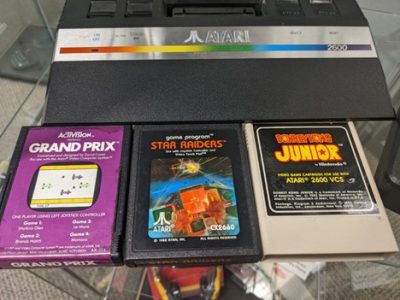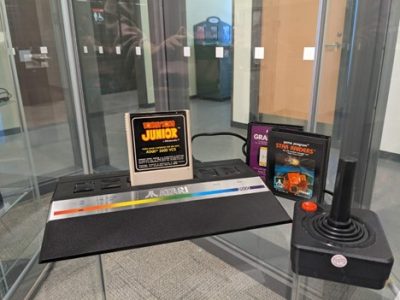Video Game Console
Manufacture Period: 1997
Serial No. AT8607787218
After the Video Game Crash of 1983, Atari went from having the most popular console of the time period to losing hundreds of millions of dollars.
Formed in 1972, Atari initially produced arcade machines with notable titles like Pong and Breakout. After an array of clones began to hit the market, the company began developing home consoles so people could play these same arcade games in the comfort of their home. These were only single title limited releases, such as 1975’s PONG, but computational technology made it possible to develop hardware with swappable cartridges—a major step forward for the home gamer at the time. Atari released the Atari Video Console System (Atari VCS) in 1977, later renaming it the Atari 2600 to better align with long term branding goals. Being the first video game system with swappable cartridges meant video game development possible without needing to invest in system creation. In 1983, after speculation on the video game market, the industry was oversaturated with poor quality games and an excess number of unsold consoles. Atari and many other video game developers had major revenue drops and reported large losses. At its peak between 1979 and 1981, Atari had a market share as high as 90%.
This model is the second revision of the Atari 2600 and was rereleased in 1986, being called the Atari Jr. in some territories. Trying to piggyback off Nintendo’s success with their North American release of the Nintendo Entertainment System (NES) in 1985, Atari found modest success with a redesign, a small catalogue of new releases, and a steep price cut to $49.99 USD. Though it could not compete with its contemporaries or the more modern systems, Atari released games for the system up until 1990 and today it is a popular console for homebrew (or fan made) games thanks to the accessibility of the software.
On loan from Prof. Josh Greenberg

Atari games
Activision’s Grand Prix (1982)
Activision was the first third party developer in the video game industry. They also started the tradition of achievement badges in video gaming, with some instruction books, like Grand Prix, telling players to send pictures of their high scores to the company and getting a patch in return if reaching the score threshold.
Atari’s Star Raiders (1980)
Ported to the Atari 2600 in 1982 by Carla Meninski, Star Raiders was packaged with the Touch Pad. This missing attachment was similar to a remote, allowing player to use an array of buttons for game play and simulate the computer inputs from the original version. The gameplay featured first-person combat in outer space and is considered to be widely influential to later games of the genre.
Nintendo’s Donkey Kong Junior (1982)
Originally an arcade game, Donkey Kong Junior was ported to the Atari 2600 by Coleco in 1983 and is the only game to feature Mario as the villain. Playing as Donkey Kong Junior, the player would attempt to navigate through hazards on the screen to collect keys and unlock Donkey Kong. This is also the only game in our collection to have the art displayed right side up when inserted into the system. This orientation would become standard with later releases and on succeeding game systems.
Thursday, February 2, 2023 in Media Museum
Share: Twitter, Facebook




